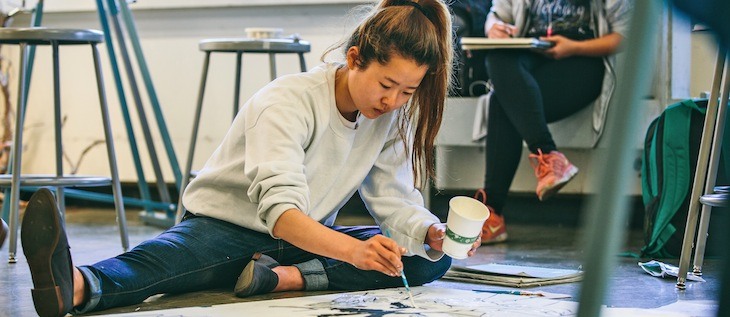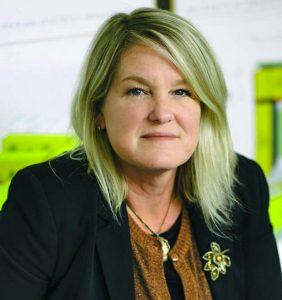UA School of Art preps for Ph.D. program, expected enrollment bump
by October 23, 2017 6:29 pm 486 views

The University of Arkansas School of Art faculty is in the midst of strategic planning for a significant expansion that will unfold during the next half-decade.
The wheels have been in motion for years toward the transition from what was formerly known as the art department to the School of Art. In fact, establishment of the school was quietly approved by the UA board in the fall of 2016, and the school received accreditation from the National Association of Schools of Art and Design in April.
Interim director Jeannie Hulen said the School of Art also has made key faculty hires and other changes in anticipation that funding from the Bentonville-based Walton Family Charitable Support Foundation would come through — and it did. The school announced its planned expansion and a $120 million gift from the foundation in August.
“We’re not starting from scratch. There’s 142 years of an art program on this campus,” she said. “Now, with financial support, we can go to that next level.
“We’ve established a very solid foundation and have a lot of very successful faculty and students,” she added. “The support foundation understood that. The reason they’re investing in this program is because they saw that this was a good investment to boost the creative economy.”
Big changes ahead for the school include two new Ph.D. programs, in art history and art education, that the school hopes to launch within the next three years. If the art education Ph.D. program opened today, it would be one of just 15 in the country, Hulen said. In anticipation, the school increased its art education faculty from one to three during the past year.
Since the gift announcement, the School of Art has ramped up its planning. Faculty members are writing curriculum, and the school is bracing for increased enrollment. In 10 years, Hulen hopes 700 students will be enrolled at the School of Art. There are about 400 right now, and most of the growth will be within the graduate program, she said.

A long-term hiring plan for the expansion has not yet been approved by the university, but a search is underway for a director. Hulen said she hopes to announce a name by Jan. 1. She will step into a new role, not yet announced, when a director is in place.
BREATHING NEW LIFE
Part of the Charitable Support Foundation’s gift, $10 million, will go toward a complete interior/exterior renovation of the 117,000-square-foot Fine Arts Center, but there is still money to be raised for the project.
Mike Johnson, associate vice chancellor for facilities management at the UA, said he expects the search for an architect will begin soon. A timeline for the project is dependent on decisions about swing space and other factors, but construction likely won’t be finished for several years. The remaining $110 million from the gift will fund curriculum design, faculty positions and student financial support.
The Charitable Support Foundation gives primarily to higher education. Its gifts to the UA include $50 million to the Sam M. Walton College of Business in 1998 — at the time the largest gift ever made to an American school of business, according to the UA — and $300 million in 2002 to establish the Honors College and create an endowment for University Libraries.
It is a separate entity from the Walton Family Foundation, which has long supported the arts in Northwest Arkansas and helped found the Crystal Bridges Museum of American Art.
Todd Shields, dean of the J. William Fulbright College of Arts & Sciences, said great art museums like the Art Institute of Chicago have ties to strong art schools. Therefore, an expansion of the School of Art will benefit Crystal Bridges — and the entire NWA community will benefit from a more vibrant arts and culture scene.
“One of the things we’ve seen, as we look across the country, is that the areas that continue to grow are those that invest in the quality of life,” he said, speaking directly on bringing new talent to the area. “The more we invest in the quality of life — which is fine arts, in many respects — we counter any negative images of the state someone from Los Angeles or New York, for example, might have.”
ARTS & COMMUNITY
To that end, the School of Art is looking to connect to the community. One possible avenue toward that goal is the establishment of an arts district on Government Avenue, off Martin Luther King Jr. Boulevard in Fayetteville. Ceramics has already relocated to a new facility at the location, but the “dream” is to build more structures and create a hub, Shields said.
“The fine arts really tie a university into the community,” he said. “It makes sense to bring it off the center of campus, which can be difficult to get to, and make it a destination for people to come see great art, maybe take an art class or participate in a summer program.
“We want people to be able to access art and be part of it,” Shields said. The objective is to create “an elite School of Art that also has roots in the community.”
Hulen said the specific needs of artists required the proposed facilities.
“Artists are dirty and messy. If we try to weld outside on the quad it’s not going to be good for everyone,” Hulen said, referring to fabrication of large-scale metal sculptures for public art, for example. “Also, we need 18-wheelers to get us materials, so we need a loading dock. We get 20,000 pounds of clay at the beginning of every semester.”
Also, the school needs more space, Shields said. “If it grows as quickly as we think that it will, we’re going to need new places for students.”
However, the arts district is, right now, only a “dream,” Shields stressed. “There are potential funding sources out there, but nobody’s written a check.”
LEADING THE WAY
Hulen has hope that the Charitable Support Foundation gift will only result in more funding — and not just for the visual arts.
“The School of Art is just the beginning. I think theatre and music are next,” she said.
Both programs will benefit from the Fine Arts Center renovation, with facelifts for the University Theatre and the Stella Boyle Smith Concert Hall.
“It’s wonderful,” said music department head, Ronda Mains, adding the concert hall remodel “is badly needed.”
Though a blueprint is not yet in place, Mains said a lot of the renovations will happen in the back of house.
“The plan is to enhance the service area for the hall so that it’s more functional. Right now we have to walk through on the edges of the audience to get backstage,” she said.
She hopes the renovation will alleviate that issue and provide more backstage space, including greenrooms. In the end, she believes it will “make it a better patron experience. It’s a win-win for everyone.” In terms of growing the music program, Mains said: “We’re always working on something. Right now, we’re building a jazz program and slowly, but surely, strengthening the programs that we have and making sure our retention is better.”
Michael Riha, head of the theatre department at the university, said the program has seen substantial growth since he joined 25 years ago. On the donation to the School of Art, Riha said, “I couldn’t be more elated. It’s an unbelievably generous gift, and it will only help music and theatre.”
Riha said the greatest need for his department is new facilities. He said the department needs them to be able to continue to compete nationally.
“We’ve really outgrown our space,” he said. “We’re bursting.”
He also said he is “very confident” the need will be met in the next few years, because the administration has provided “amazing and really thoughtful support” for the theatre department.
“They get it.”
The department will also have a new black-box theater at the UA Global Campus Auditorium in downtown Fayetteville. It’s being built now and planned for completion in February.
